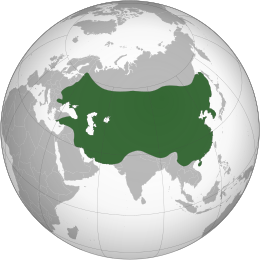Great Mongol Nation (1206–1368): Difference between revisions
(Created with background) Tag: Visual edit |
(Up to 1206) Tag: Visual edit |
||
| Line 1: | Line 1: | ||
{{Infobox country|name=Great Mongol Nation|native_name=ᠶᠡᠬᠡ ᠮᠣᠩᠭᠣᠯ ᠤᠯᠤᠰ|capital=Avarga (1206–1235)<br>Karakorum (1235–1260)<br>Khanbaliq (1271–1368)|mode_of_production=[[Feudalism]]|image_map=Mongol Empire map.svg|map_width=260|area_km2=24,000,000}} | {{Infobox country|name=Great Mongol Nation|native_name=ᠶᠡᠬᠡ ᠮᠣᠩᠭᠣᠯ ᠤᠯᠤᠰ|capital=Avarga (1206–1235)<br>Karakorum (1235–1260)<br>Khanbaliq (1271–1368)|mode_of_production=[[Feudalism]]|life_span=1206–1368|image_map=Mongol Empire map.svg|map_width=260|area_km2=24,000,000}} | ||
The '''Great Mongol Nation''', commonly known as the '''Mongol Empire''', was the largest contiguous land-based [[state]] in history. | The '''Great Mongol Nation''', commonly known as the '''Mongol Empire''', was the largest contiguous land-based [[state]] in history. | ||
| Line 6: | Line 6: | ||
=== Background === | === Background === | ||
In the early 11th century, feudal states began forming in [[Mongolia]]. [[Khabul Khan]], great-grandfather of [[Genghis Khan|Chinggis (Genghis) Khan]], became the first khan (leader) of the Khamag confederation, which collapsed in 1166 after his grandson [[Yesugei]] was poisoned. | In the early 11th century, feudal states began forming in [[Mongolia]]. [[Khabul Khan]], great-grandfather of [[Genghis Khan|Chinggis (Genghis) Khan]], became the first khan (leader) of the Khamag confederation, which collapsed in 1166 after his grandson [[Yesugei]] was poisoned. | ||
Temüjin (later named Chinggis Khan) made an alliance with [[Jamukha]] and [[Toghrul]] to retake his father's vassals and defeated the Merkit confederation. He then fought with Jamukha over who would rule the Khamag and defeated him in | Temüjin (later named Chinggis Khan) made an alliance with [[Jamukha]] and [[Toghrul]] to retake his father's vassals and defeated the Merkit confederation. He then fought with Jamukha over who would rule the Khamag and defeated him in 1190, becoming khan. He gave privileges to tribal leaders (''noyod'') who supported him and established a [[ruling class]] of ''darkhan'' that were exempt from [[Tax|taxes]], could hoard war loot instead of dividing it, and were not punished for their first nine offenses. | ||
Around 1200, Temüjin and Toghrul joined a campaign against the [[Tatars]] and defeated Jamukha again. In 1202, they defeated the Merkits, but Toghrul then allied with Jamukha against Temüjin. By 1206, Temüjin united all of Mongolia under his rule.<ref name=":0">{{Citation|author=A. A. Guber, et al.|year=1973|title=History of the Mongolian People's Republic|title-url=https://archive.org/details/HistoryOfTheMPR/page/n8/mode/1up?view=theater|chapter=|page=|city=[[Moscow]]|publisher=USSR Academy of Sciences}}</ref><sup>106–8</sup> | |||
== References == | == References == | ||
Revision as of 14:34, 3 June 2023
| Great Mongol Nation ᠶᠡᠬᠡ ᠮᠣᠩᠭᠣᠯ ᠤᠯᠤᠰ | |
|---|---|
| 1206–1368 | |
 | |
| Capital | Avarga (1206–1235) Karakorum (1235–1260) Khanbaliq (1271–1368) |
| Dominant mode of production | Feudalism |
| Area | |
• Total | 24,000,000 km² |
The Great Mongol Nation, commonly known as the Mongol Empire, was the largest contiguous land-based state in history.
History
Background
In the early 11th century, feudal states began forming in Mongolia. Khabul Khan, great-grandfather of Chinggis (Genghis) Khan, became the first khan (leader) of the Khamag confederation, which collapsed in 1166 after his grandson Yesugei was poisoned.
Temüjin (later named Chinggis Khan) made an alliance with Jamukha and Toghrul to retake his father's vassals and defeated the Merkit confederation. He then fought with Jamukha over who would rule the Khamag and defeated him in 1190, becoming khan. He gave privileges to tribal leaders (noyod) who supported him and established a ruling class of darkhan that were exempt from taxes, could hoard war loot instead of dividing it, and were not punished for their first nine offenses.
Around 1200, Temüjin and Toghrul joined a campaign against the Tatars and defeated Jamukha again. In 1202, they defeated the Merkits, but Toghrul then allied with Jamukha against Temüjin. By 1206, Temüjin united all of Mongolia under his rule.[1]106–8
References
- ↑ A. A. Guber, et al. (1973). History of the Mongolian People's Republic. Moscow: USSR Academy of Sciences.